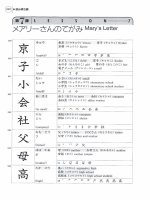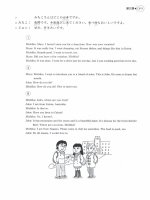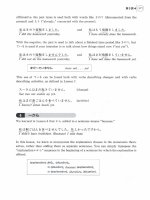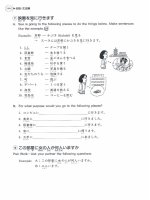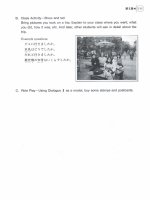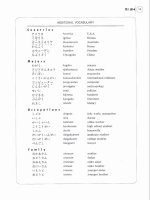genki 1 an integrated course in elementary japanese1 phần 9 ppt
Bạn đang xem bản rút gọn của tài liệu. Xem và tải ngay bản đầy đủ của tài liệu tại đây (3.72 MB, 34 trang )
(v)
%79=3hmlp383
Mary's
Weekend
266
(I)
%_)ab(Da
bX
b
33
My
Favorite
Restaurant
;hf=l,
276
(-1
%
7
9
-&/u@~
~AF~
~ary's
~etter
282
(=)
H*)=aa
Japanese
Office
Workers
287
1LWu
bL\L+Llhr
(-1
@a
ue5
The
Folktale
Kasajizo
298
(TI
gE)s%
Looking
for
Friends
304
is
Lw3
%
1
2
a
9
Tanabata
Festival
0
tts
(2%
310
(Refer
to
"Japanese
Writing
System"
on
pages
18-22
for
more.
details.)
@
Hiragana
Practice
A.
Choose
the
correct
hiragana.
B.
Match
the
words.
Person's
name
1.
&Qi55
Akai
2.Tp&Z*
Nakamura
3.$57p~\
Takahashi
4.
tat%
Z
-
Tanaka
5.
t
Morikawa
6.
Q-hxk&
-
Sakurna
7.
&
9
-hab
Yamarnoto
8-$<2
Hashimoto
3.me
$2
bj
6-
chi
''%
9.e
X,
PIace
name
9.
37126
lo.
jaj
Z-
11.
$#2
12.
Gg
3
fib
-
13.
3523
1
=
14.
y4is
15.
16.
-b
12
-
Gifu
Beppu
-
Sapporo
Osaka
Kyoto
-
Kanazawa
Nagasaki
Chiba
C.
What's
wrong
with
the
hiragana
below?
Rewrite
the
correct
hiragana.
D.
Write
as
many
hiragana
as
possible
which
contain
the
following
parts.
E.
Put
the
hiragana
in
the
right
order
to
make
sense.
Example:
&=.
&
%
+
?!.
%
f2.G
1-
b&T
@
Reading
Practice
Read
what
the
following
people
are
saying
and
answer
the
questions.
1.
Who
is
an
office
worker?
2.
Whose
major
is
Japanese?
3.
Who
is
a
high
school
student?
4.
What
is
Harada's
major?
@
Writing
Practice
You
received
a
letter
from
a
Japanese
friend.
Read
it
and
write
a
letter
introducing
yourself.
*fjFk&t
<f;#a~lr\l.\t3Tis
more
polite
than
tf
3
P
k
6
L
<
.
jII9hf
Katakana
75,
-tj-
so
7
tu
3-
I\
ha
ma
Y.
Ya
3
ra
7
,a
[Refer
to
"Japanese
Writing
System"
on
pages
22-24
for
more
details.)
*
ki
9
shi
F
chi
-
-
ni
t
hi
\
\
mi
'1
ri
3
ko
Y
so
b
to
ku
su
'
its,
r-
e
9-
k&?
*
se
?-
te
3
fiu
7
fu
A
ma
2
YU
/k%
$\
ne
%
he
%
me
Ln?
/'
no
-f-
'ho
*
m*
3
YO
13,
'yo
@
Katakana
Practice
A.
Choose
the
correct
katakana.
1.6
7
4.
shi
2
'y
7.m
t
IL
B.
Match
the
following
words
and
pictures.
C.
Match
each
country
with its
capital
city.
Countries
1.
TL 27
2.
$7
27'
3.
7-%'1Y7
4.
z97p
5.
$ ;Cb7'17-
6.29~-7.9
7*4>F
8.
7lb%.>F
2
9.
7W-Y.
Capital
Cities
$97
73=/1.>DC
2
3.
-7
11
-
7Axylby~LA
7731~>7 1~
7-zlxP-t
vx
+*
9x3
7S4u
Xhy?rf;~LA
D.
Word
Search-Find
the
following
country
names
in
the
box
of
katakana.
b
t-
L.
(Vietnam)
3
3
iS*$
-
Jl.
(Singapore)
?-
s
3
(Czech)
7'
%
'1
fi
(America)
2
5'
r
-
2
(Sweden)
X
57
7'
F
IL
(Ecuador)
%
+
3
3
(Mexico)
7*?
3
lb
(Brazil)
jK
2
-
7
(Bosnia)
7f
7
2
9-
(Holland)
4
;/
F
5'
7
(Indonesia)
3-
7
(Canada)
Jt
7
2
?*
(Rwanda)
9
4
(Thailand)
7f
-
2
P
3
'1
7"
(Australia)
E.
Put
the
kafakana
in
the
right order
to
make
sense.
Example:
3
.f-
+
9
-*
@
Reading
Practice
Mary
wrote
about
the
things
below.
Find
out
which
item
she
wrote
about.
1.
(
)
2hli
hk
Lo
C4i
L
U?
W
9
2+?&,
+?.i-Sh@
EZi
LTT,
-
z-3-7T=/+-XO
I%$
LTTo
@
Name
Tags
Write
your
name
in
the
box
below
and
make
your
own
name
tag.
.
.
Example:
7'
1
9
IL
-2
3
1
9+
=/
@Writing
Practice
Write
about
the
things
you
or
your
classmates
own.
Use
Mary's
sentences
in
1
as
a
model.
4
V?f
I-*&
(4
*%
p*
4
fit-year
student
-9
(4
Y
72)
one
minute
-9
(U
2
7)
one
&?&
(-3-
>*
4
)
second-year
student
rq
(ak~)
two
sag7
(a%n?l
two
days
Eq&
(YY;l;
2-kd
1
third-year
student
57
(G3-33)
thee
(k
%
2-k
4
)
fourth-year
student
W9
73)
fow
(P8Yl
Apd
1
*Tf& $.
.
~
.
,-
.
-
He.
1:
-
35*
.
.
3%-
(t3'73)
five
(%a31
seven
$13
7.
t
k
(+
z
91
nine
he
(3'
9)
nine
o'clock
LZQI
kg
I+=~I;l+f4)
nineyearsold
%7
(ZZa)?)
nine
(nine)
(Vz=LS)
bn
+q
(9393)
teno'clmk
-f-%
(9z~Sf-4)
ten
years
old
-5
(kg)
ten
(2)
-
+
(t:
+-
9
1
Aand~ed
2s
(YL'
F
T
3
)
three
hundred
(u
Y
?
3
six
hundred
rkz
(~1
l*
3
eight
hundred
(In
this
chart,
katakana
indicates
the
om'ymi
[pronunciation
originally
borrowed
from
Chinese]
and
hiragma
indicates
the
kuz
%mi
[native
Japanese
reading].)
012
013
014
015
(6)
-
TR%'
=k
(*
9)
thousand
C?f2@&-33y~ee
thousand
('1
.;)
-k
21
eight
thousand
(3)
'
T
-5
(-4
#
7
2)
ten
thousand
fx
(
9
=L
9
Ty)
one
hundred
thousand
SZ
(
k
~3
2)
one
million
(3)
-
3
5
(
'.P;.p;m@*~&a~&Un~~
yen
F¶
circle
(4)
1
n
fl
fl
%
.E3$%7$%3
o'clock
?fE
(
Z
F
b
r7,k
8
in
one's childhood
~4'(k3ZI*=i)sornetime~
q$+(F3-4>watch
0011
n
R
fl
R'
8+
(hundred)
422
-lie=/
T
F9
El+
(thousand)
7-2
(ten
thousand)
x>
(yen;
circle)
-2
z3
(time)
@
gTa@a
(Kanji
Practice)
h
L
fihL93
A.
Read
the
price
of
the
following
items
in
kanji and
write
it
in
numbers.
Example:
T3~k-b
(l))h)fi?
B.
Write
the
following
prices
in
kanji.
Example:
T5,420
+
3?-~'iZ~~fl
An
international
exchange
student
writes about
his
daily
routine.
Read
the
passage
to
find
out
about
his
schedule
and
fill
in
the
blanks below.
7:OO
(
1
9:
00
(
1
4:OO
6:
00
I
)
watch
TV
go
to
the
university
eat
lunch
@
a
<
@g
(Writing
Practice)
fS
hhrLw5
Write
about
your
daily
routine.
Use
the
above
passage
as
a
model.
tCyCr)I/c;b
583
Mary's
Weekend
$579
C
7J
=.y
(day;
sun)
aEl(~4fF)
everyday
-&Gr)EI(kib$.o)UI)
Mother'sDay
B~C(~w+f=)diary
ZEI
(5~A)threedays
a*
[**2)*~*&
El
*%
(z*
23)
Japanese
language
I&$-$
X/
(+
&
&
23
L)
Mr./Ms.
Ymamota
I
(book;
basis)
ese
peo&
Z
ah
(
Z
0
0
k
1
this
person
=A
(9
2
=
>)
three
people
I
/
(moon;
month)
J(41
)
fl fi
a
K
(U)
fire
ozr
Y
$542
(%&lda)
money
(In
this
chart,
katakana
indicates
the
on
'yomi
and
hiragan@
indicates
the
k%c~'yomi.)
&%
El
(
F
3
9
IF)
Saturday
zk
(7%)
soil
(3)
-
+
~3
qz
a
(=
+
s.%sha=d%~
0
I
n
1
B
E~
$
B
PPFFTq1$q%@q
k
t3i
k)
top;
&OV&
l+2
(V3
PA&)
good
at
EL
(73-3
9
3
9)
rooftop
(3)
1
F
1
T
(Lk>
under
%T%
(9-2
YY>
subway
T*fa'
(-?:a>
poor
at
(3)
-
T
T
q(a;b.)inside
+E(Q=.fdP)China
q?
(#23#3)
juniorhighschool
-*+
(4
+%Y9=9)
all
year
around
.
-
EqF
(*&gqPW)
F%
(/\YYj.)
half.
.+!r*-f
,
.
-
.
(5)
'
.
P
1->
P
-
*
5
0g
4-
Ti)
+
F
5-G
Isoil)
39
(weekday)
i
2
733
(UP)
tfz
(down)
3
&%
'f23
yip
(middle)
(half)
@
(Kanji
Practice)
h'hl
I;
fLhrbD3
A.
Match
the
kanji
with
the
English
equivalents.
Sunday
Monday
Tuesday
=
Wednesday
=
Thursday
Friday
Saturday
B.
Look
at
the
picture
and
choose
the
appropriate
kanji
for
the blanks.
%711-3PU[2Sfi'dS*hIZ%€S;h\SZ
I/ko
Read
the
memo
and
answer
the
questions.
Read
the following
passage
about
Mary's
weekend.
&+k
store
SaPtC:'?
sweetbun
%
k;%
(
late
Arrange
the
following activities in the order
Mary
did.
1.
studied
Japanese
2.
bought
sweet
buns
3.
went
to
a
restaurant
4.
watched
TV
5.
went to
a
park
@
g<
(Writing
Practice)
a
fi~v~~3
A.
You
are
going
out.
Write
a
memo
to
someone
in
yourkouse,
telling
when
you
will
be
back
and
whether
you
will
have
dinner
at
home.
6.
Write
about
your
weekend.
9d;Zj
Travel
(mountain)
(spirit)
(heaven)
(I;
private)
(rice
field)
8.
am&
S-f-A
(7992)
Mt.
Fuji
%R
(YY+)
electricity
XR
CF~/+)
weat&
xg
(7
2
93)
heaven
$A&A*
(P
'I
Y
9-1'
2-f
5'
private
university
EehiZ
(fzL&X)
rice
field
(511
n
m
w
m
*ah
(%j'h.&E~Uk)
woman
*/$i
(93-k4>
woman
%
1
(to
go)
I
R
k
339'
(to
eat)
SZZ
*.
(man)
I
(to
drink)
UlX
-
(Zizk
Z$YU.'k3
man
Wy* fl
man
(711
nmwm
9
35
29
(to
see)
&-%
B
(fi%&)
to
eat
&<%
(ke60)food
'fke
(V39F9)
cafeteria
RZI
tasee
E%
(9
2
?
'Y
>
sightseeing
(711
n
H
a
,F,q,
(9)'
/h+&e*&
*-G
;'@a)
$0
drink
@k&%
(a&
6
a))
drink
&%g%
(4
Y~.z~Y?Y)
drunken
driving
03'
.'
4
4
4
$
$
f
pf$&
(In
this
chart,
kutakam
indicates
the
m'yomi
and
hiraga~ara
indicates
the
km'ymi.)
->\.*
~
;h'k
t;
fi/vb@J
A.
Using
the
parts
below,
make
up
the
correct
kanji.
Example:
a
+
B.
Match
the
following
sentences
with
the
pictures.
C.
Match
the
kanji
with
the
reading.
l.(
)-s
2.(
)=a
3.
(
)
SF3
4.
(
5.( )5El
6.(
)*B
7.(
)+€3
8.(
9.(
)*a
lo*(
)+a
11.(
)=+a

